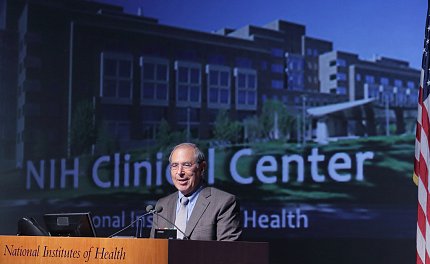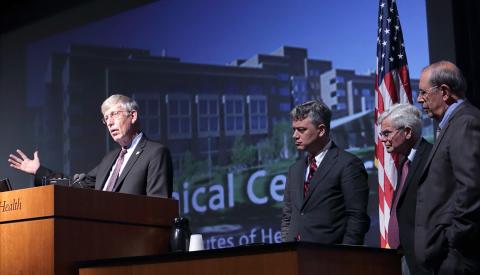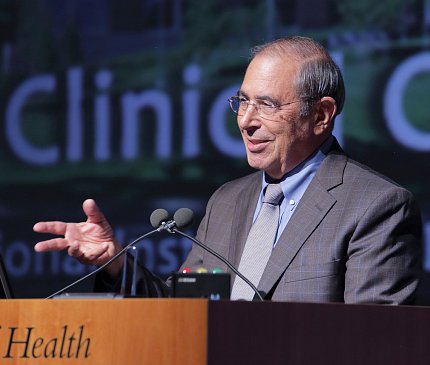‘House of Hope’ Enters New Phase
At Latest Town Hall, CC’s Future To Be Determined by Those Who Know It Best

Photo: Ernie Branson
People who know the Clinical Center best should take the lead in shaping its future. That was the message Sept. 7 at the latest CC Town Hall Meeting to give a progress report on NIH’s effort to restructure hospital operations. NIH director Dr. Francis Collins also introduced several new NIH staff members and components involved in strengthening the Clinical Center and encouraged a new outlook.
“Our efforts here will shape the future of biomedicine and the future of every single patient that comes through our doors seeking answers and looking for hope, because we are, after all, the House of Hope,” said Collins, who opened his remarks with a “big shout-out” to CC staff.
“I think you are among the most dedicated and visionary medical researchers and caregivers on the planet,” he said, noting that he has recently been going on patient rounds with some of the CC’s ward teams. “I see your commitment to outstanding patient care and extraordinary scientific accomplishment as truly inspiring. Thanks to you, many lives have been saved and many more will be saved in the future…The Clinical Center is rightly a national treasure. Our goals with the steps that are under way and that we’ll be talking about today are not to do anything that would harm that status as a national treasure; no, but instead to make that national treasure even more perfect.”

Photo: Ernie Branson
Restructuring was prompted more than a year ago, following discovery of major lapses in preparation of sterile injectables in the pharmacy. That led to a comprehensive review of the hospital by an external team of experts known as the Red Team, which offered a critical appraisal and a number of recommendations to enhance patient safety.
At this town hall, Collins urged NIH’ers to recognize the Red Team recommendations as a starting point, but to develop our own improvement plan.
Let’s “collectively say, ‘Maybe there are some things that we could be even better at,’” he suggested. The inclination now should be “not to defend against what was already said, but to consider improving in ways that haven’t been mentioned…People [already here] know a lot more about the Clinical Center than any external group ever will,” he said, talking to an audience composed mainly of CC staff. “You probably have some ideas about things that could run more smoothly, things that could be better for research and better for patient care. That’s what we want to capture…I hope we take this opportunity to think positively and creatively about how to make this place even more amazing.”

Photo: Ernie Branson
CC director Dr. John Gallin, who in August accepted a newly created dual position as NIH associate director for clinical research and chief scientific officer for the Clinical Center, expressed his eagerness to get started on a new path forward.
His new role, he said, will allow him “to help expedite some of the very positive changes that will transform our clinical research resources to levels that have not previously been possible. For this to happen, we all need to embrace some new activities.”
He described seven major functions of his new post:
- Oversight of scientific review for all clinical protocols in the intramural program
- Setting priorities across institutes and centers for clinical research conducted here
- Oversight of strategic planning for intramural clinical research
- Review of IC directors’ oversight of their clinical directors
- Scientific direction of the CC, overseeing independent research programs of investigators working at the CC
- Developing strategic partnerships to expand clinical research collaborations among intramural and extramural programs, and
- Oversight of clinical research training programs.
“I’m anxious to get things moving quickly—even before the new CEO is identified,” he said. “The initial priorities will be the first two duties…I look forward to pursuing this new adventure with you.”

Photo: Ernie Branson
NIH deputy director for intramural research Dr. Michael Gottesman talked briefly about two new groups that will also help map out new ways for the Clinical Center to operate: a steering committee consisting of senior NIH clinicians and leaders, chaired by Gottesman, and a CC engagement working group representing a cross-section of NIH that will organize focus sessions to collect essential commentary and suggestions from those who know the CC best—staff and patients.
“We all know that the Clinical Center is the physical and emotional heart of the NIH campus and what you do is provide hope to all of the patients who come here, sometimes with profoundly difficult and debilitating diseases,” Gottesman noted. “The purpose of the meeting today is to get your input on a process we are assembling to allow you to be the determinants of the change we make at NIH. It’s really important that the people who work in the trenches are involved in the changes that are inevitably going to happen. And we want this opportunity for you to speak up about the process we’re going to use.”
Collins introduced several other new components and members of the CC leadership team:
- NIDCD scientific director Dr. Andy Griffith will oversee the new Office of Research Support and Compliance (ORSC) until a permanent director is recruited. He will chair the CC engagement working group.
- Dr. Bruce Burnett, a regulatory compliance expert on loan from Duke University for a year, will play a leading role with ORSC.
- A lawyer with expertise in human subjects protection, Valerie Bonham, has joined NIH as ORSC deputy.
- Dr. Majid Tanas began work last month as new chief of the pharmacy; Dr. Carolyn Lawrencot is senior regulatory affairs specialist for pharmaceuticals development.
Leading the discussion with the focus groups, which will consist of NIH staff, will be Stewart Simonson, former HHS assistant secretary for public health emergency preparedness (2001-2006).

Photo: Ernie Branson
“My happiest memories of that time are here at NIH,” he said, moderating the open mic portion of the town hall. “Of this place, I have nothing but happy memories. On this campus, there is no place more important to me than the Clinical Center. [Former HHS Secretary Tommy] Thompson used to say the Clinical Center was, in his experience, ‘the most moving, the most tender-hearted and the most impressive institution in all of HHS.’ And my experience was that too.”
He said he’s prepared to convene “as many focus groups as interest warrants…There are no limits within reason to what we will discuss. The purpose of these sessions is not to re-litigate or flyspeck the Red Team report, [but] I also don’t want to suppress discussion in any way…What comes out of these focus groups will be faithfully carried forward to the new CEO, the hospital board and to Bldg. 1.”
The focus groups that Simonson leads will be formed from NIH staff who can sign up at http://intranet.cc.nih.gov/focusgroups.html.

Photo: Ernie Branson
Collins summarized the first meeting of the new hospital board of directors, held in July. He mentioned that the CEO search, under way across the nation, will close soon.
“Your input is an essential component of the decision-making process,” he concluded. “I know that change can be sometimes unsettling and disruptive, and we want to hear your thoughts about how to make this place even better…Change can be unsettling, but standing still in an area where science is changing rapidly, and so is medical care, would be potentially even more perilous. The promise of change—especially sagely directed by the insights and experience of one of our nation’s most brilliant and caring workforces, that’s you—is very compelling.”
NIH’ers can view the entire meeting at https://videocast.nih.gov/summary.asp?Live=19661&bhcp=1.
